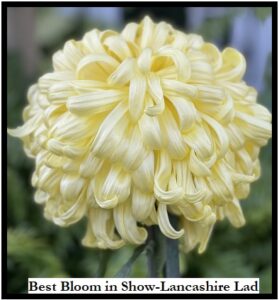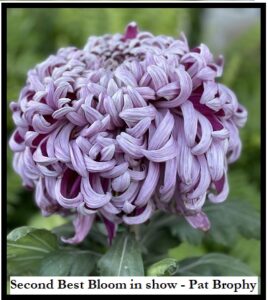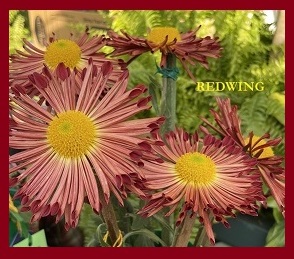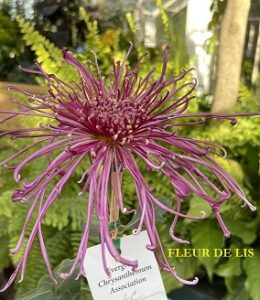This month the focus is on finishing the blooms, preparing them for transport to the show and the grooming and presentation of the blooms for the show.
1. Care and feeding,
-Tie cedar support stakes under the blooms to keep the stems straight and the blooms upright. A cocked bloom will be severely discounted by the judges. Keep raising the support stake up against the bottom of the bloom to prevent or correct cocking.
-Tie cedar support stakes under the blooms to keep the stems straight and the blooms upright. A cocked bloom will be severely discounted by the judges. Keep raising the support stake up against the bottom of the bloom to prevent or correct cocking.
-Water and feed plants sparingly at this time (October time frame). Feed with liquid fertilizer solution about 1 pint at each watering. See fertilizer recommendations below. It’s a good practice to make up a 30 gallon garbage can of the fertilizer solution and set this can out in the sunlight so that it will remain relatively warm. Then water/feed out of this barrel. Note: If you use fresh tap water instead, you will be watering/feeding with a water temperature below 50 deg. That sets back the plant each time you water. Water/feed sparingly, preferably around 5:00 pm. Some prefer to water early in the day, but if you do be sure to use the warm water from the barrel.
-The recommended dilution of the fertilizer is: ½ tsp of the standard 20-10-20 midseason fertilizer plus ¼ tsp Sulphate of Potash (0-0-50) per gallon of water. That’s essentially half the usual dilution of (20-10-20) you’ve been using for mid season plus the potash is added to harden off the stems and the petals
.
-Sheltering your plants is crucial. Get the plants moved into some sort of shelter where the blooms are protected from rain, dew, wind and direct sunlight. It does not have to be a totally enclosed shelter but enclosed shelters prove to be of advantage in developing near perfect blooms. The blooms do not need direct sunlight but some filtered sunlight is desirable. I have pinned white sheets under clear roof panels. This filters the sun and additionally collects dew that collects on the panels at night. If you move your plants into enclosed spaces then you must also provide lots of cool dry ventilation to protect against petal rot. Multiple fans blowing gently across the blooms is the usual solution. It’s generally desirable to keep the daytime temperatures below 75 degrees and the night time temperatures above 50 degrees during this final bloom phase.
-Sheltering your plants is crucial. Get the plants moved into some sort of shelter where the blooms are protected from rain, dew, wind and direct sunlight. It does not have to be a totally enclosed shelter but enclosed shelters prove to be of advantage in developing near perfect blooms. The blooms do not need direct sunlight but some filtered sunlight is desirable. I have pinned white sheets under clear roof panels. This filters the sun and additionally collects dew that collects on the panels at night. If you move your plants into enclosed spaces then you must also provide lots of cool dry ventilation to protect against petal rot. Multiple fans blowing gently across the blooms is the usual solution. It’s generally desirable to keep the daytime temperatures below 75 degrees and the night time temperatures above 50 degrees during this final bloom phase.
If you move your plants into area where the sunlight is poor or non existent, then you will need considerable supplemental light as discussed in the Sept. To Do list.
-Watch for Aphids and other insects. The Marathon systemic insecticide you added in June or July should protect you very well from Aphids; but it does not catch all insects and bugs, and if you didn’t use it or used a diluted application then it’s possible you could find aphids and other insects such as earwigs in your blooms. Earwigs have to be handpicked from the blooms and other such bugs must be caught with a watchful eye before they severely damage the bloom. If the blooms are dry and out of the sunlight it is possible to spray the bloom with a very fine solution of liquid insecticide such as diazinon or other mild insecticides. Generally you will need to spray every 4-5 days apart for 3 or 4 applications. This could in some cases destroy your blooms; but then so would the Aphids. If aphids are in the blooms at the show it will be downgraded, or if badly infested the bloom will be removed from the show.
You need to keep your blooms clean during the bloom development so when damaged petals or rot marred petals are found you should remove them so as not to propagate the problem. Generally speaking you can, with dry fingers, take hold of the petal end and gradually pull and swirl the petal around. This will generally loosen the root and the petal will come out. Sometimes you need to use tweezers to get the petal. Homemade wooden tweezers are preferred.




